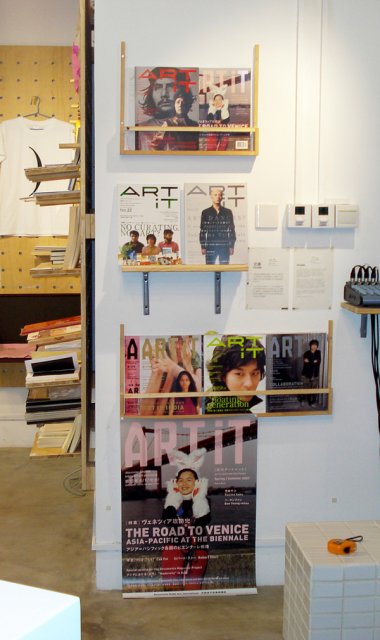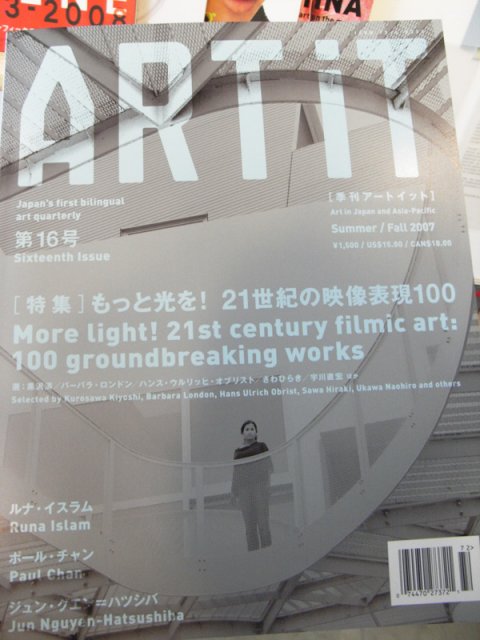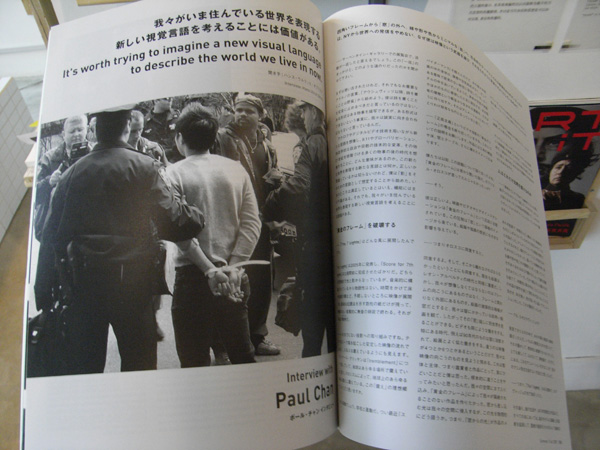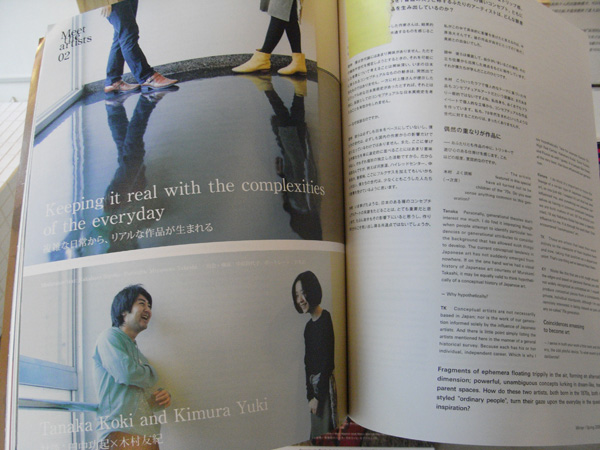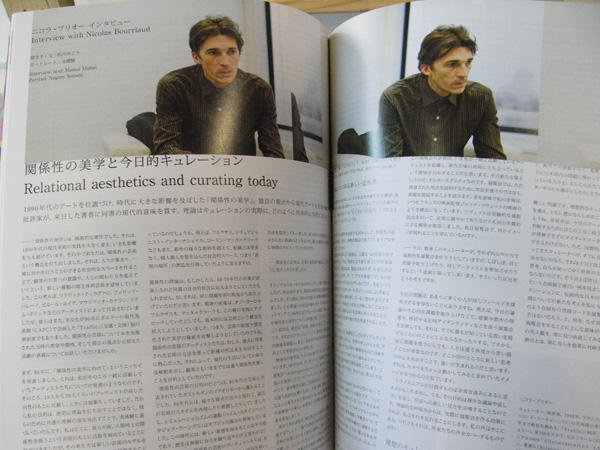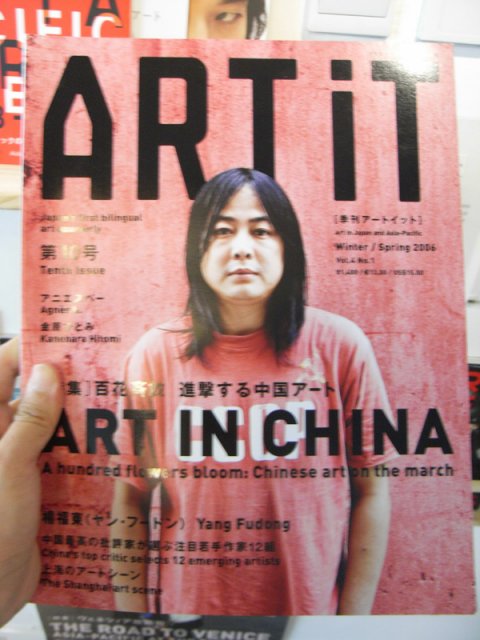Please come by the shop to check out the Façade’s 4th edition, a set of the magazine Artit, the bilingual (Japanese and English) quarterly focussing on the Asia-Pacific art world. Its first issue was published in 2003 in Japan but now has wide international distribution. Artit has ceased printing on paper and is now going to be totally online!
This brings a few ideas to mind about media, which are inspired by Artit, but may or may not be totally relevant to their current state; anyhow, it is a very interesting time for media, so I thought I would share some thoughts below!
As print media of every type face numerous challenges as well as new opportunities, we begin to see what print media was; object, archive, billboard, narrative, at times a critical space. (I also think of the very material quality of the accidental that print encouraged, for example in newspapers the disaster scenes co-existing with the luxury watch ads – what the Canadian artist Jon Knowles has termed grotesques trouvées.) We wonder how these aspects are ‘transferred’ to the digital space, or how new ones will arise of their own logic.
At a panel discussion involving a dozen professionals of the art media a couple years ago in Frankfurt, I once heard the director of the artforum.com website frankly describe the role of the online forum as being a ‘transmitter of information’, a term I can’t say I have precisely heard used when describing a print magazine. Transmission is definitely the strongest and most general use of the internet so far (and where it is allowed), and simply requires a source. Anything can be transmitted.
It is clear that media has shaped the understanding of the world and especially the art world, which has been commented on by many artists as being the site where most people experience art. I suppose if there is one supplement that is crucial to the development of the mechanism of transmission (maybe it could be called the critical function) it would be not only knowing, but continually reminding us of, the difference between the experience and the transmission itself. In reportage this is the pointed and articulated awareness of sources and uses of images and information, not only their distribution; if it isn’t called the ‘critic’ then perhaps it is the ‘realism’ of media.
There is no apparent reason the critic (if that is what they would be called) can’t flourish in the digital forums, and so with one technology ‘replacing’ another, panic and despair express only sentimentality for forms. But still, looking at relatives in the news media, new questions arise. For instance, in his speech to a hearing on the crisis of news media (“endangered species”, John Kerry called it), David Simon (ex-reporter in Baltimore and creator of “The Wire”) forecast the death of “high journalism” if real wages and some sort of regulation of the industry – in short, conservation of professional journalists – were not quickly ensured. Simon admits that the internet allows for a form of democratization and for many more people having voices, but worries that because of a profit-driven approach to media, critical and consequential journalism will die.
Simon says: “Indeed, the very phrase “citizen journalist” strikes my ear as Orwellian. A neighbor who is a good listener and cares about people is a good neighbor; he is not in any sense a citizen social worker, just as a neighbor with a garden hose and good intentions is not a citizen firefighter. To say so is a heedless insult to trained social workers and firefighters.” And he also says: “But you do not, in my city, run into bloggers or so-called citizen journalists at City Hall or in the courthouse hallways or at the bars where police officers gather. You don’t see them consistently nurturing and then pressing others—pressing sources. You don’t see them holding institutions accountable on a daily basis. Why? Because high-end journalism is a profession. It requires daily full-time commitment by trained men and women who return to the same beats day in and day out.” Transmission, potentially infinitely reproducible by all, is perhaps not enough. To what extent can one make similar demands on the art media, one wonders?
This is obviously quite a crucial point for journalism, where the facts must be straight and the perspective must be clear, which is seemingly less of an ‘issue’ with art media, but still interesting to ask if the web-based approach of blogs, secondary information, and forums by “non-professionals” has relevance and impact for art, which is also obviously affected. If you look at all the symposiums wondering about the fate of art criticism (symposiums which sometimes seem so self-important), it seems there is a similar question about crisis.
With Artit magazine, transition is an unforced and deliberate move. It is a good occasion to consider its changing role as a site for the binding together and questioning of Asia-Pacific art, and to understand the benefits of a ‘formal’ change.
(You can see the video from David Simon’s speech here:
http://www.democracynow.org/2009/5/7/david_simon_creator_of_acclaimed_hbo)
Michael Eddy
Previous “Façade”:
No.1 MEWE Designed Books
No.2 About Hans Ulrich Obrist
No.3 Printed Matter
About “Façade”:
“Façade” will be flexibly taking a certain space ( a wall, a corner or a special designed struture depending the whole spacial situation) at the shop to constantly have thematic or untitled presentation of publications that will highlight different dimensions of the conceptual approach of publication practices. As such, “Façade” will try to mediate these creative publications to the public as well as to raise the discourse of the how contemporary knowledge/thought can be visualized, expressed and circulated.
Over time, the accumulation of the publications from the “Façade” presentations will gradually form a “Façade Library”, providing a free access for the public to read and think.
“Façade” is conceived by the shop in Beijing.
